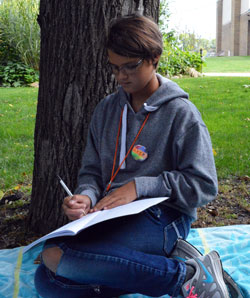Ryder Nichols sketched a map. He drew his neighborhood from a bird’s-eye view with zoomed-in details of his home.
He sketched the wooded area near his house where lots of fun happened, like when he built a humongous fort. He plans to write about that experience and others he’s had in his neighborhood — which he’s indicated on his map — this school year.

“I feel like the memories will help me have something to write about,” Ryder said.
That’s what Nickels Intermediate sixth-grade teacher Melissa Thomas was hoping. Students’ maps are meant for the safekeeping of memories and to spur ideas for when they write personal narratives. The idea, which Thomas learned about at a conference, comes from children’s author Jack Gantos’ Secret Tips For Aspiring Authors. As a child, Gantos would sketch maps of the many homes and neighborhoods he lived in to keep track of his experiences.
The maps — which are drawn like a house with its roof removed, and covered with written memories or doodles — can be as intricate as students choose.
Cameron Payne sketched the pool he once walked right into with all his clothes on. Savannah Schmitz marked the spot where a bird pooped on her bed after it flew in the house when a door was left ajar. And Elly Watt drew where she fell off her bike when riding to get ice cream, injured her teeth and had to have a root canal.

“It’s giving me ideas about what I should write about,” Elly said.
The students keep writers notebooks, which serve as inspiration journals.The maps will go in the notebooks.
“We spend time the first few weeks of school building all different ways to pull memories — we call them seeds of ideas — to help generate stories,” Thomas said.
It’s a way to get students started when they sit down with paper and pencil. “That’s the hardest part: ‘I have a blank page. How do I begin?’” she said. “If we have all these generated ideas, we can select one from there and go.”













